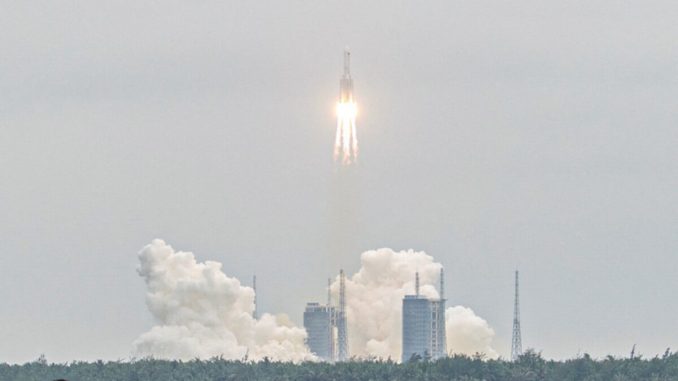

Commentary
China apparently plans to cause recurrent waves of panic by launching uncontrolled rockets that threaten people on Earth, and soon, also on the Moon.
At first, Chinese space officials thought that the country’s 20-ton Long March-5 booster stage would impact in the Eastern Mediterranean Sea on May 9, causing concern in Israel, but it instead crashed in the Indian Ocean. The Pentagon was asked if it had plans to shoot it down.
At least three more Long March-5 space launch vehicles (SLVs) will be used to complete China’s space station, another three will be needed to launch planned probes to the Moon.
There is also the prospect that China will subject future inhabitants of the Moon to the same potentially deadly drama. In both cases, it may be the lack of power or launch capacity of China’s SLVs that requires compromises that put others in danger.
China’s Long March-5 SLV can only lift about 25 tons to Low Earth Orbit (LEO), and the Tianhe space station module launched on April 29 weighed about 22 tons. It did not use a second stage to achieve orbital velocity so the large first stage had to perform this mission, but it was not equipped for controlled deorbit, meaning its descent could endanger people on Earth.
Between 2025 and 2030, China is expected to use its new “921 Rocket” which reportedly can put 27 tons into Trans-Lunar Injection (TLI), or transport to the Moon.
As China’s next-generation manned spaceship configured for lunar missions weighs about 21 tons, this means that China will require two 921 Rockets to send the manned spaceship and the manned Moon lander to rendezvous in lunar orbit.
At a major space conference in 2018, and more clearly at another in September 2020, Chinese military-space officials revealed some configurations for a manned Moon lander, an initial Moon shelter, and a large manned Moon rover that can also serve as a shelter.
While these may not be final designs, they seem to share a characteristic derived from the former Soviet Union’s aborted manned Moon program. As the Soviet’s large N-1 SLV could only put 23 tons into TLI, and it had to carry both the manned spaceship and Moon lander, the latter had to be lightweight.
One solution was to devise a special rocket stage called Block D that would decelerate and descend its 5.5 to 6.5 ton LK (Lunniy Korabyl, Lunar Craft) manned Moon lander to about 2.4 miles (4 kilometers) above the Moon. At that point, the Block D would detach from the LK and crash into the Moon.
The expendable Block D did not require the additional weight of landing legs. By comparison, the contemporary U.S. Apollo program Lunar Excursion Module (LEM) weighed 15 tons, but its descent stage made a controlled landing on the Moon.
The LK’s internal Block E engine complex would complete the landing and later return one Cosmonaut to a spaceship orbiting the Moon. China is reported to have purchased the designs for the Block E engines from their Ukrainian designers. It is likely they also gave China insights into the integral Block D engine complex.
We can infer this possibility because the Chinese manned lunar lander, shelter, and rover concepts revealed to date also employ a detachable stage just like Block D, apparently also designed to crash into the Moon.
But by the 2030s, the Moon could become a crowded place, with the United States and its Artemis Moon program partners likely building multiple Moon Bases. Based on revealed Chinese estimates, China may build up to 10 Moon bases that it will require 60 of its super heavy-lift Long March-9 SLVs between 2030 and 2035.
Furthermore, early Moon exploration and Moon Base building for the United States and China will be concentrated at the South Pole of the Moon, where there are higher concentrations of lunar ice water. This means that U.S. and Chinese Moon bases may sometimes be in close proximity.
While China’s Long March-9 super heavy SLV could put up to 50 tons into TLI, meaning larger and safer Moon lander designs could be accommodated, there remains the possibility that China could also require scores of 921 Rockets using Block D-like decent stages to build an early presence at choice South Pole lunar locations.
So, in addition to having to endure added drama from the potential danger of more Long March-5 SLV booster stages hitting populated areas of the Earth, early Moon explorers may also have to endure the danger of Chinese “Block D” descent engines impacting near or on their Moon Bases.
A Chinese refusal to modify its Long March-5 SLVs for controlled and safer descents to Earth would not bode well for a willingness to similarly modify their “Block D” Moon descent stages.
Without such modifications, it would be logical for U.S. space planners to consider both passive and active defenses for Moon Bases, like lunar laser weapons. This would violate current treaties and conventions against “militarizing” the Moon, but the alternative would be to subject U.S. government, and allied and private sector Moon personnel to the danger of Chinese “Block-D bombs.”
China, however, may desire this outcome, as it would justify the militarization of their Moon Bases already controlled by its People’s Liberation Army, making them ready to assert Chinese claims to Moon territory and wage battles for eventual control of the Moon.
Richard D. Fisher Jr. is a senior fellow and policy analyst with the International Assessment and Strategy Center.
Views expressed in this article are the opinions of the author and do not necessarily reflect the views of The Epoch Times.





Be the first to comment